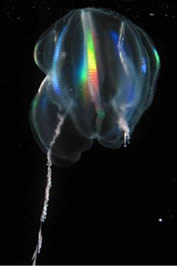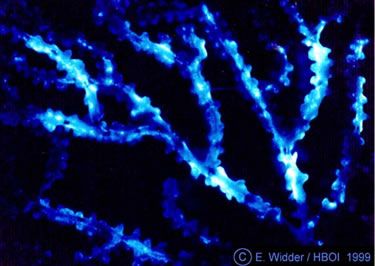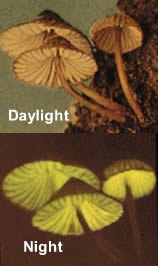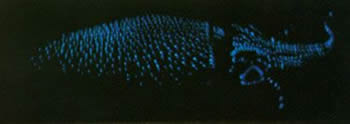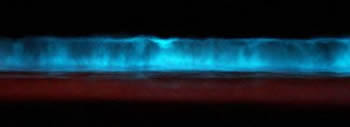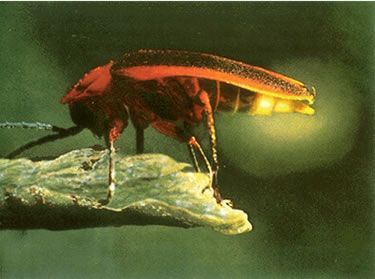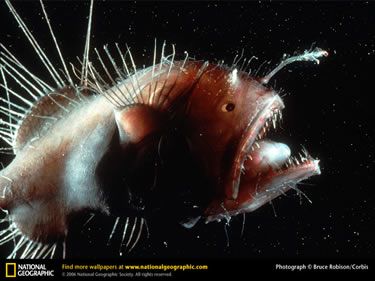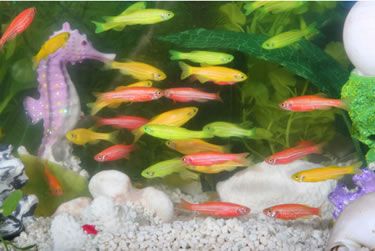A page from the "Causes of Color" exhibit...
Light made through chemical reactions in living things

Bioluminescence
When chemoluminescence takes place in a living organism, the process is termed bioluminescence. Increasingly, scientists are taking our knowledge of bioluminescence, particularly in marine creatures, and finding new applications in chemistry, genetics, ecology and medicine.
Where do we see it?
Bioluminescence produces a range of effects in a jellyfish, bamboo coral and mushrooms. |
||
A squid is highlighted in bright bioluminescent spots. Huge numbers of dinoflagellates associated with red tide phenomena produce fluorescence when breaking waves trigger a bioluminescent reaction. |
|
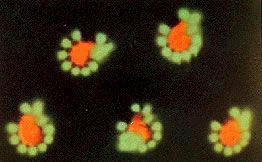
The railroad worm’s unusual flashes emit two different colors at once.
There are a number of lower species of animal, algae, fungi, and bacteria with bioluminescent properties. Fungi and bacteria tend to emit a continuous glow when the process is triggered. In contrast, algae and animal species emit a light that flashes.
Insects, scorpions, and marine creatures (such as jellyfish, squid, and deep-sea fish) use bioluminescence. In fact, it is estimated that up to 90% of deep-sea creatures produce some form of bioluminescence. Because the red end of the visible light spectrum is absorbed before reaching the deep sea, most of the light emitted is blue and green. However, there are species that emit red and infrared light, and one genus has been found to emit yellow bioluminescence.
The organs responsible for emitting bioluminescence in these creatures are known as photophores.
Fireflies
The best-known bioluminescent creature is the firefly. In the firefly, the chemicals luciferase and luciferin combine with adenosine triphosphate (ATP) to form the luciferase-luciferin-ATP complex. ATP is found in cells to provide energy for essential cellular processes. The complex quickly goes from its excited state to a lower energy state, emitting the difference in energy as visible light with a greenish glow.
All firefly larvae are bioluminescent, while some adult species do not have the ability to glow. Firefly larvae are sometimes referred to as glow-worms, but true glow-worms are similar to beetles, and are also bioluminescent.
Why does bioluminescence occur in nature?
Bioluminescence has five functions that have been identified to date: camouflage, attraction, repulsion, communication (between bacteria), and illumination.

When using its bioluminescence and seen from below, the cookiecutter shark disappears into the background, leaving a dark spot as bait for would-be predators, which become prey when they venture too close. |
A variety of explanations have been put forward as to the purpose of bioluminescence. Some fireflies emit light in a particular flash pattern that uniquely identifies its species. Females respond to males of their own species with a corresponding flash pattern. |
The glowing of firefly larvae may be a deterrent to predators, signaling the presence of unpleasant-tasting chemicals. Some species of squid and crustaceans use clouds of bioluminescent slurries to confuse predators, just as other species of squid use ink.
The role of the flashing light of adult fireflies is more complex, with some species relying purely on pheromones to attract a mate, while others developing unique patterns and rates of flashing. The flash rate may change to indicate to a flying male that a female on the ground is interested in his advances. The length of time between the male flash and the female response is also used to identify females of the same species.
The females of the Photuris species have developed an “aggressive mimicry,” copying the flash pattern of different species to trap and devour the male as prey.
Glow-worm females may also glow while curled around their eggs.
In deep-sea fish, bioluminescence provides illumination for particular species that emit red bioluminescence, enabling them to see red pigmentation in their prey.
Bioluminescence may also be used to attract prey. The anglerfish dangles a glowing appendage in front of its large and toothy jaws as bait for smaller fish.
Engineering bioluminescence
Genetically modified organisms utilizing bioluminescence include transgenic mice, fish, and microbes such as bacteria and fungi. Genetic modification is surrounded by controversy, as our ability to create new genes, and new organisms, has outstripped our knowledge of their long-term effect on broader ecosystems. It is also a fascinating and exciting field, as fluorescent genes open up new perspectives on the inner workings of cells themselves.
Fluorescent genes, such as the gene GFP found in jellyfish, or luciferase from fireflies, can be directed to target a specific mammalian gene, revealing the exact locations of the particular protein associated with that gene within a cell. This is an invaluable tool in medical research, pharmaceutical development and drug screening, gene therapy, and improving our understanding of biological processes.
These GloFish are zebra fish genetically modified to fluoresce. Fluorescent jellyfish genes are added to fish eggs, and passed on genetically when this generation reproduces. Because they fluoresce in the presence of particular chemicals, they signal the presence of those pollutants in the water. They also make attractive pets, subject to local genetic modification regulations.
There are many possible applications for engineering bioluminescence in a variety of forms. Glowing fish could make for exotic pets, while trees that include bioluminescent genes could be used to illuminate roads and highways, or to provide Christmas trees that are truly green and don’t require electricity.
Bioluminescence could also be used as a warning or flag, to show when action is required. Crops could glow to indicate they need water, bad bacteria in meat could be located, glowing tags could identify escaped criminal offenders, and contaminated water could be flagged and monitored.




